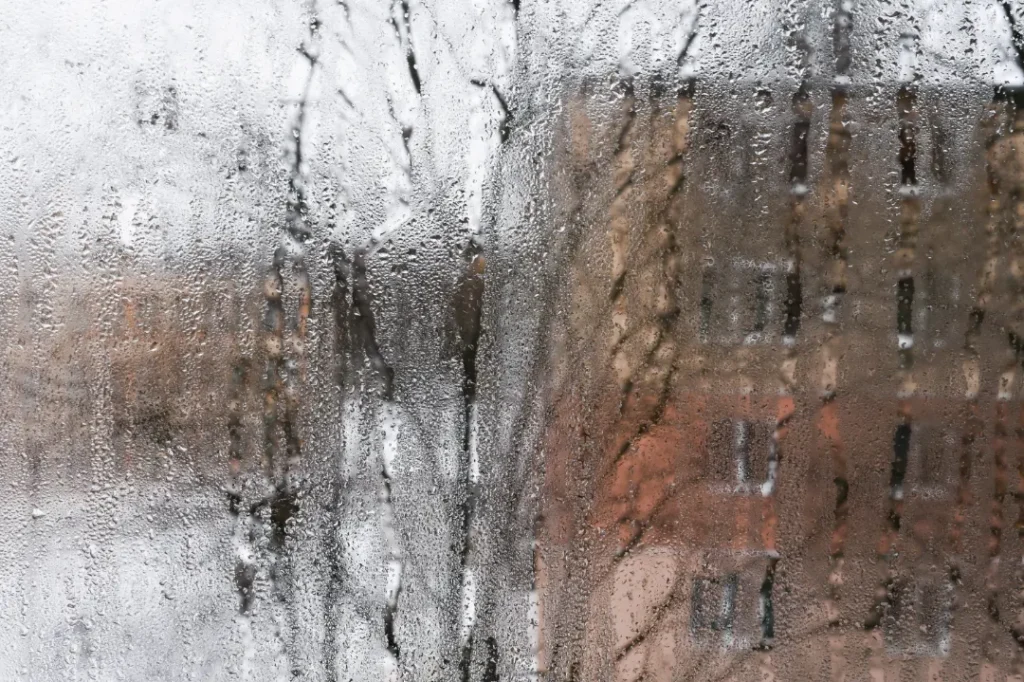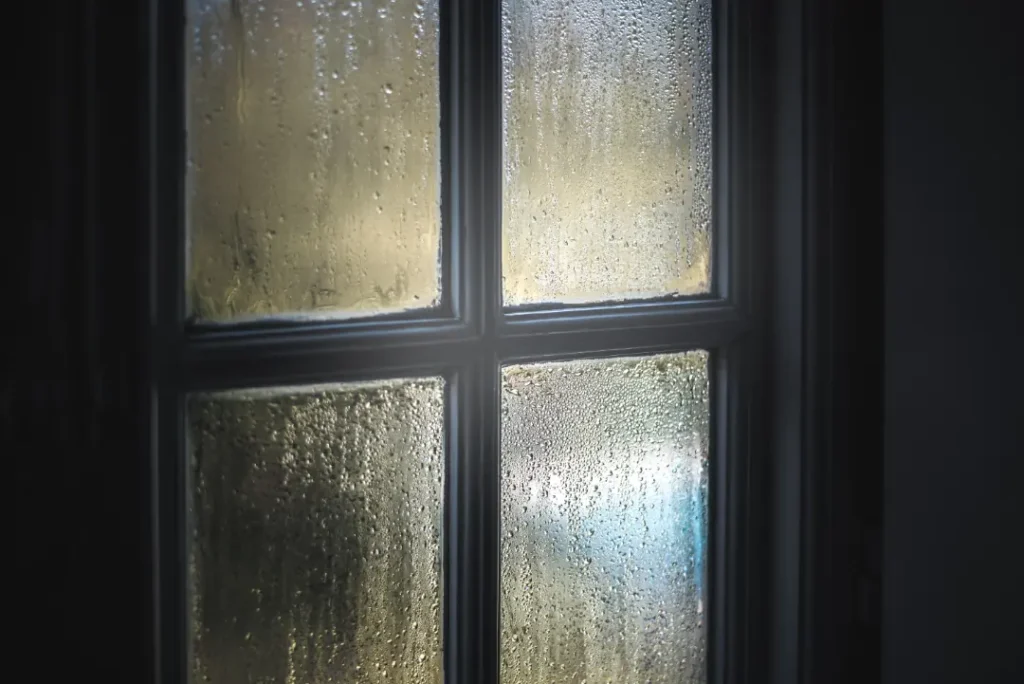Condensation on windows can cause mould, water damage, and reduced visibility. This guide explains how to prevent condensation on windows with practical tips and long-term solutions to keep your home comfortable and dry.
Key Takeaways
- Condensation on windows is primarily caused by temperature differences, high indoor humidity, and poor ventilation, particularly during winter months.
- Immediate actions to reduce condensation include increasing air circulation, controlling indoor humidity, and adjusting thermostat settings.
Understanding Window Condensation
If you’ve ever noticed water droplets forming on your windows, especially during the colder months, you’ve seen condensation in action. This happens when warm, humid air inside your home meets the cooler surface of the window, causing the moisture in the air to turn into liquid. The bigger the temperature difference between indoors and outdoors, the more noticeable this condensation becomes.
Condensation on windows isn’t just a visual nuisance—if it’s not dealt with, it can lead to bigger issues like mould growth and dampness. Factors such as indoor humidity and poor ventilation often worsen the problem. By keeping an eye on these elements, you can take simple steps to manage or prevent window condensation and maintain a healthier living environment.

The Role of Temperature Differences
Condensation on windows often occurs because of temperature differences between the cold outdoor air and the warm indoor air. When the warm air inside your home hits the cooler surface of the window, it cools below the dew point, causing water vapour to condense into droplets. This is why condensation is more common during the winter months when the contrast between indoor and outdoor temperatures is greater.
Maintaining adequate heating inside can help raise the temperature of internal surfaces like windows, reducing the likelihood of condensation forming.
Impact of Humidity Levels
High indoor humidity is another major factor in window condensation. The more moisture there is in the air, the higher the chances of condensation, as warm air holds more water vapour. Everyday activities such as cooking, showering, or even keeping indoor plants can increase humidity, leading to condensation on windows.
To manage this, aim to keep indoor humidity between 40-55%, using ventilation, dehumidifiers, and extractor fans in kitchens and bathrooms to prevent moisture buildup.
Poor Ventilation
Poor ventilation is often the hidden culprit behind persistent window condensation. When air can’t circulate properly, moisture gets trapped indoors, making condensation worse. This is especially true in modern, energy-efficient homes, which are sealed to save energy but often hold in too much moisture.
Improving air circulation by opening windows, using vents, or installing exhaust fans can go a long way in preventing condensation while balancing energy efficiency with effective ventilation.
Immediate Actions to Reduce Condensation
Taking quick action to reduce or stop condensation on windows can help prevent mould growth and protect your windows from damage.
When done correctly, these measures can significantly cut down on condensation, helping you maintain a healthier, moisture-free home.
Increase Air Circulation
Improving air circulation is key to reducing window condensation. You can start by using a fan or cracking open a window to allow better airflow in your home. Using exhaust fans in moisture-heavy areas like the kitchen and bathroom also helps clear out moist air.
For a quick boost in ventilation, try opening your windows wide for 20 minutes each day. Also, keep air vents and fans clean and in good working order to ensure they’re running efficiently.
Control Indoor Humidity
Using a dehumidifier is one of the most effective ways to reduce condensation. It lowers humidity levels inside, making it harder for moisture to accumulate on your windows. Be sure to choose the right size and type of dehumidifier for your space, and place it strategically—near air vents, for example—for maximum effectiveness.
Adjust Thermostat Settings
Balancing your thermostat is another way to prevent condensation. Keeping your indoor temperature steady and consistent helps reduce the temperature difference between the inside and outside, minimising condensation on windows, especially during winter.
A well-regulated indoor environment will go a long way in reducing the risk of condensation while keeping your home comfortable and dry.
Long-Term Solutions for Preventing Condensation
Consider upgrading insulation, installing double or triple-glazed windows, and improving home ventilation for a permanent solution to window condensation.
These long-term strategies can provide lasting prevention against condensation, ensuring a more comfortable and energy-efficient home environment.

Upgrade Insulation
Enhanced insulation maintains a uniform indoor temperature, reducing condensation. Insulating windows reduces the temperature difference between the inside and outside, thereby minimising condensation. Insulation regulates temperature and reduces moisture, preventing warm air from reaching cold surfaces.
Insulated walls and double-glazed windows play a significant role in managing window condensation.
Install Double or Triple Glazed Windows
Double or triple-glazed windows significantly reduce winter condensation, improving comfort and indoor air quality. These windows help prevent condensation by maintaining a warmer temperature on the inside windowpane, compared to single-glazed windows, due to a thermal barrier.
Upgrading to double or triple-glazed windows enhances insulation and energy efficiency by reducing heat loss. Proper installation ensures maximum insulation benefits.
Improve Home Ventilation
Extractor fans in high humidity areas like bathrooms and kitchens significantly manage moisture levels. Leaving the extractor fan on for 10-15 minutes after cooking clears the humid air. Exhaust fans, attic fans, and open windows improve airflow and reduce condensation.
Keeping kitchen and bathroom doors closed prevents moisture from entering colder rooms where it can condense.
Specialised Equipment to Combat Condensation
Specialised mechanical solutions may be needed to manage moisture effectively for more severe condensation issues. These systems, ranging from extractor fans to advanced ventilation units, are designed to eliminate excess moisture and prevent condensation from forming on cold surfaces while also promoting healthier indoor air quality.

Heat Recovery Ventilators
A heat recovery ventilator (HRV) is a powerful system that exchanges stale indoor air with fresh outdoor air while minimising heat loss. By transferring heat from the outgoing air to the incoming fresh air, HRVs help maintain a comfortable indoor temperature and reduce the chances of condensation. These systems can preserve up to 80% of the heat from the air leaving your home, making them an efficient way to improve ventilation and reduce condensation risk.
HRVs not only help prevent moisture buildup but also improve overall air quality, creating a fresher, healthier living space.
Positive Input Ventilation Units
Positive Input Ventilation (PIV) units are another effective solution. These units work by continuously introducing filtered outdoor air into your home, which balances indoor humidity and keeps condensation at bay. By replacing humid indoor air with drier, cleaner air, PIV systems prevent moisture buildup that leads to condensation, especially on windows.
PIV units, like the Vent Axia system, also help remove pollutants, ensuring better air quality while preventing mould and condensation problems.
Storm Windows
Storm windows provide an extra layer of insulation, which can be a game-changer in reducing window condensation. By lowering the temperature difference between the inside and outside, they reduce the likelihood of condensation forming on your windows. Storm windows also improve energy efficiency, helping to retain heat and prevent unnecessary heat loss.
Choosing the right storm windows and ensuring they are properly installed can maximise their effectiveness in reducing condensation while boosting your home’s insulation and energy savings.
Maintenance Tips to Keep Windows Condensation-Free
Keeping your windows free from condensation requires regular upkeep. Simple steps like cleaning, checking seals, and preparing for seasonal changes can make a big difference. By following these maintenance tips, you can prevent moisture buildup, extend the life of your windows, and maintain a healthier indoor environment.
Regular Cleaning
Wiping away interior window condensation regularly is a quick but effective way to prevent moisture-related problems. It keeps your windows clear of excess moisture that could lead to mould and damage. Regular cleaning not only keeps your windows looking good but also helps extend their lifespan by preventing issues caused by constant moisture.
Seal Checks and Repairs
Damaged window seals can let moisture in, reducing insulation and increasing condensation. Checking the seals around your windows and repairing any damage helps prevent exterior condensation and ensures your windows are performing at their best. Simple fixes like applying weatherstripping tape or caulking can seal leaks and keep your home better insulated.
Seasonal Preparations
Preparing your windows for colder weather is essential to minimising condensation. Seasonal changes often affect indoor moisture levels, so adjusting your thermostat to maintain a balanced indoor temperature can help reduce condensation. Improving insulation around your windows ensures consistent indoor temperatures, further preventing condensation buildup when the weather turns cold.
Combat Window Condensation with Professional Help
While immediate solutions like increasing air circulation and adjusting your thermostat can help reduce window condensation, your home’s long-term health and comfort often require expert intervention.
Protect Your Home with Our Mould and Condensation Experts
At Environ Property Services, we offer professional mould and condensation solutions for London properties. Our solutions ensure long-term results that safeguard your home and health. If left untreated, condensation can lead to damp walls, dripping windows, and even harmful mould growth.
Our team has successfully eliminated condensation damp from thousands of homes. We focus on addressing the root causes to prevent reoccurrence. With our expert damp surveys, we’ll identify potential structural issues and provide tailored solutions to keep your home dry and comfortable.
When it comes to condensation, the right treatment depends on the cause.
If your home is showing signs of condensation or mould, don’t wait for the damage to escalate. Contact Environ Property Services today to schedule a thorough mould and condensation survey. We’ll recommend the best long-term solutions, including PIV units and professional mould removal, to ensure your property remains safe, dry, and mould-free. Get started today for a permanent solution to your condensation issues!
Frequently Asked Questions
What causes condensation on windows?
Condensation on windows is caused by the interaction of warm, humid air with cooler surfaces, resulting in the formation of water droplets. Ensuring proper ventilation can help mitigate this issue.
What causes condensation on windows, and how can I prevent it?
Condensation occurs when warm, humid air hits a cold surface, causing condensation to form on the window. Excessive moisture can worsen this, but installing air bricks or improving ventilation can help prevent it.
What are the benefits of double or triple-glazed windows in preventing condensation?
Triple or double glazing significantly reduces condensation by keeping the interior surface of the glass warmer. This enhances insulation and energy efficiency, ultimately contributing to a more comfortable and healthier indoor environment.
Conclusion
Tackling condensation on windows requires a comprehensive understanding of its causes and the implementation of both immediate and long-term solutions. Increasing air circulation, controlling indoor humidity, adjusting thermostat settings, upgrading insulation, and installing double or triple-glazed windows are all effective ways to manage and prevent window condensation. Regular maintenance, combined with seeking professional help when needed, plays a crucial role in keeping your home condensation-free.
At Environ Property Services, our expert team specialises in identifying and addressing the root causes of condensation and mould. With our professional damp surveys and tailored solutions, you can protect your home from potential health risks and property damage, ensuring a comfortable and healthy living environment.

